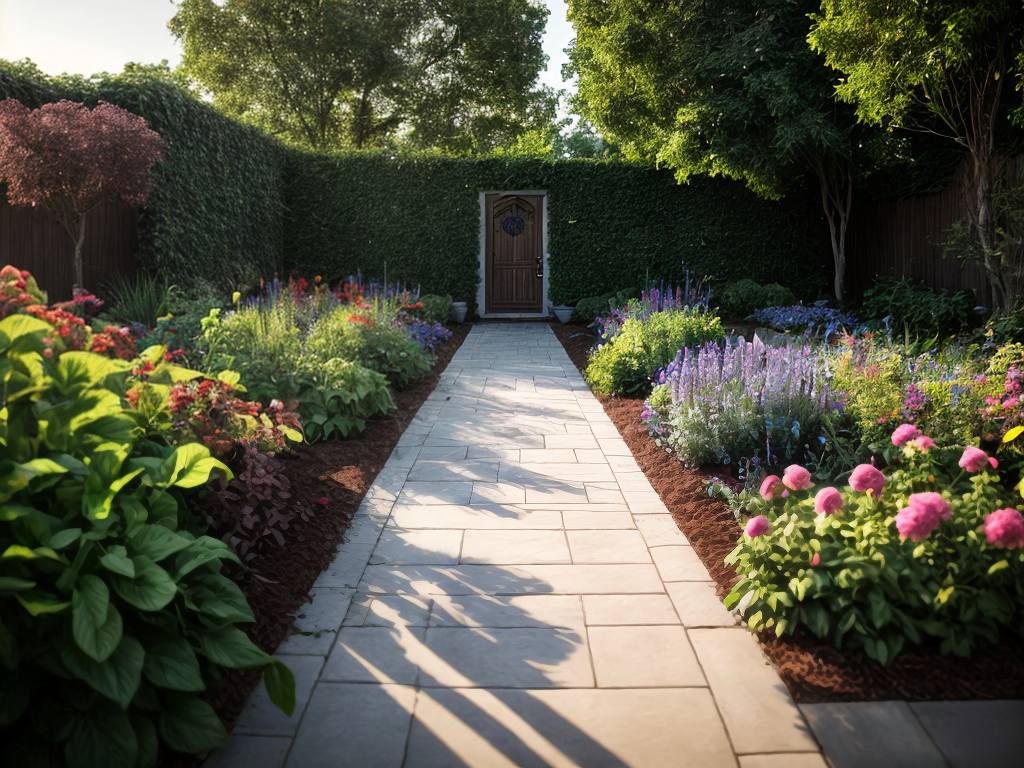
As I step into my backyard, I can’t help but marvel at the transformation it has undergone in recent years. Gone are the days of plain grass and cookie-cutter flower beds; today’s landscaping trends have brought a breath of fresh air to outdoor spaces. From sustainable gardening practices to water-wise landscaping, there are countless ways to make the most of your yard. But where do you begin? In this discussion, I will explore the latest landscaping trends that will not only enhance the beauty of your yard but also create a functional and sustainable outdoor oasis. So, put on your gardening gloves and join me on this journey of discovery.
Sustainable Gardening Practices
Sustainable gardening practices are essential for maintaining a healthy and environmentally-friendly landscape. When it comes to landscaping, it is important to consider the environmental impact and adopt eco-friendly practices. By implementing sustainable gardening techniques, we can ensure that our landscapes thrive while minimizing harm to the environment.
One key aspect of sustainable gardening is water conservation. By using efficient irrigation systems, such as drip irrigation, we can reduce water waste and promote the efficient use of this precious resource. Additionally, capturing rainwater through rain barrels or cisterns can further reduce the need for supplemental irrigation.
Another eco-friendly practice is the use of organic fertilizers and pesticides. These natural alternatives help to minimize the negative effects on soil and water quality, as well as the health of plants, animals, and humans. Composting is also important for sustainable gardening, as it allows for the recycling of organic waste and the creation of nutrient-rich soil amendments.
Furthermore, incorporating native plants into our landscapes can have a positive impact on biodiversity and ecosystem health. Native plants are adapted to the local climate, require less water and maintenance, and provide habitat for native wildlife.
Native Plant Landscaping
Native plant landscaping offers numerous benefits for both the environment and homeowners. When designing a native plant garden, consider the following:
-
Preservation of biodiversity: By using native plants, you support the preservation of local flora and fauna. Native plants provide food and habitat for birds, butterflies, and other pollinators, helping to maintain a healthy ecosystem.
-
Water conservation: Native plants are adapted to the local climate and require less water once established. By incorporating them into your landscape, you can reduce water consumption and save money on irrigation.
-
Low maintenance: Native plants are well-suited to the local environment and often require less maintenance than non-native species. They are more resistant to pests and diseases, reducing the need for chemical treatments.
To maximize the benefits of native plant landscaping, consider the design of your garden. Group plants with similar water and light requirements together, creating microclimates that promote growth. Use layers of different plants to create visual interest and provide habitat diversity. Additionally, choose native plants that bloom at different times of the year to ensure a continuous source of nectar for pollinators.
Vertical Gardens and Living Walls
Vertical gardens and living walls have become increasingly popular in modern landscaping designs. These innovative green wall designs offer a unique way to incorporate plants into urban spaces, maximizing limited square footage and adding a touch of nature to any environment. Vertical gardening techniques allow plants to grow vertically, using specialized structures like trellises, modular panels, or even living wall systems. These systems provide a vertical framework for plants to climb, enabling them to thrive in spaces where traditional gardening may not be feasible.
Green wall designs offer numerous benefits beyond their aesthetic appeal. They can improve air quality by filtering pollutants and increase insulation, reducing energy costs. Additionally, vertical gardens can help reduce noise pollution and provide a habitat for beneficial insects, birds, and butterflies. Maintenance for these living walls typically involves regular watering, pruning, and monitoring for pests or diseases.
When designing a vertical garden or living wall, it’s important to consider factors such as light exposure, water drainage, and plant compatibility. Choosing plants that are well-suited to vertical growth and have similar water and light requirements will help ensure a successful and thriving green wall.
Outdoor Living Spaces
Outdoor living spaces are a must-have in modern landscaping. Cozy seating areas provide a comfortable and inviting space for relaxation and entertaining. Outdoor kitchens, fire pits, and fireplaces add functionality and warmth to these spaces, creating a perfect setting for gatherings and enjoying the outdoors.
Cozy Seating Areas
Creating a comfortable and inviting outdoor living space is a popular trend in landscaping. One way to achieve this is by incorporating cozy seating areas into your backyard retreat. Here are three reasons why these seating areas are a must-have:
-
Relaxation: A cozy seating area provides a perfect spot to unwind after a long day, allowing you to enjoy the peaceful ambiance of your outdoor space.
-
Socializing: Whether it’s hosting a small gathering or simply enjoying a conversation with a loved one, a cozy seating area encourages social interaction and creates an inviting atmosphere.
-
Connection with nature: By placing your seating area strategically, you can enjoy the beauty of your backyard while being surrounded by nature, providing a sense of tranquility and rejuvenation.
Outdoor Kitchens
When designing a landscape, incorporating an outdoor kitchen can elevate your outdoor living space to a whole new level. Outdoor kitchens are a popular trend that allows you to enjoy the great outdoors while cooking and entertaining. With an outdoor kitchen, you can indulge in outdoor grilling and alfresco dining, creating a seamless transition between cooking and dining areas.
Here is a table highlighting some key features of outdoor kitchens:
| Features | Benefits |
|---|---|
| Built-in grills | Convenient for outdoor cooking and grilling, allowing you to prepare delicious meals with ease. |
| Outdoor countertops | Provides ample space for food preparation and serving, making it easy to entertain guests. |
| Outdoor sinks | Allows for easy clean-up and eliminates the need to run back and forth to the indoor kitchen. |
| Outdoor seating | Provides a comfortable area for guests to relax and enjoy their meals in the fresh air. |
Incorporating an outdoor kitchen into your landscape design not only enhances the functionality of your outdoor space, but also creates a stylish and inviting atmosphere for all your outdoor gatherings.
Fire Pits and Fireplaces
Incorporating fire pits and fireplaces into your outdoor living space adds a cozy and inviting ambiance for gatherings and relaxation. Here are three reasons why you should consider adding these features to your yard:
-
Warmth and Comfort: Outdoor heaters, such as fire pits and fireplaces, provide warmth on chilly evenings, allowing you to enjoy your outdoor space even when the temperatures drop. Imagine sitting around a crackling fire, sipping hot cocoa, and feeling the warmth on your face.
-
Socializing and Entertainment: Fire pits and fireplaces create a focal point for socializing and entertaining guests. They provide a natural gathering spot where friends and family can come together, share stories, and create lasting memories.
-
Fire Pit Safety: It’s important to prioritize safety when using fire pits. Ensure proper ventilation, keep flammable materials away, and never leave a fire unattended. Always follow the manufacturer’s guidelines for safe and responsible use.
Water-Wise Landscaping
To conserve water and create an environmentally-friendly landscape, I highly recommend implementing water-wise landscaping techniques. One of the most effective ways to achieve this is by incorporating drought resistant plants into your yard. These plants are specifically chosen for their ability to withstand dry conditions and require minimal watering. Some popular drought resistant plant options include succulents, lavender, and ornamental grasses. By choosing these plants, you can significantly reduce your water consumption while still maintaining a beautiful and vibrant landscape.
Another key aspect of water-wise landscaping is the use of xeriscaping techniques. Xeriscaping is a landscaping method that focuses on minimizing water usage through strategic design and plant selection. This involves grouping plants with similar water needs together, using mulch to retain moisture in the soil, and implementing efficient irrigation systems such as drip irrigation. Additionally, incorporating features like rainwater harvesting systems can further reduce the need for additional water sources.
Smart Irrigation Systems
If you are looking to further optimize your water usage and make your landscaping even more efficient, consider implementing smart irrigation systems. These innovative systems utilize smart irrigation technology and water-efficient sprinklers to ensure that your plants receive the right amount of water at the right time. Here are three reasons why smart irrigation systems are a great addition to any landscape:
-
Water conservation: With smart irrigation technology, you can minimize water wastage by only watering your plants when they actually need it. Smart systems use weather data and soil moisture sensors to determine the optimal watering schedule, saving you both water and money.
-
Precision watering: Traditional sprinkler systems often result in over-watering or under-watering certain areas of your landscape. Smart irrigation systems use water-efficient sprinklers that deliver water precisely to where it is needed, ensuring that every plant gets the right amount of water to thrive.
-
Remote control and monitoring: Smart irrigation systems can be controlled and monitored remotely through smartphone apps or computer interfaces. This allows you to easily adjust watering schedules, check on the system’s performance, and receive alerts in case of any issues, providing you with convenience and peace of mind.
Low-Maintenance Landscaping Options
When it comes to low-maintenance landscaping, there are several options to consider. One option is to choose easy-care plant varieties that require minimal attention and upkeep. Another option is to opt for time-saving landscape designs that incorporate features like mulch beds and automated irrigation systems. Lastly, implementing minimal upkeep strategies, such as using drought-tolerant plants and reducing the size of lawn areas, can significantly reduce the amount of time and effort needed to maintain a beautiful and functional landscape.
Easy-Care Plant Options
Low-maintenance landscaping options are becoming increasingly popular due to their easy-care plant options. People are looking for ways to have a beautiful yard without spending hours on maintenance. Here are three easy-care plant options that can help achieve this:
-
Drought resistant flowers: These flowers are designed to withstand dry conditions, requiring less water and maintenance. They come in a variety of colors and types, adding beauty to your yard while saving you time and resources.
-
Low maintenance shrubs: Shrubs are a great addition to any yard, providing structure and texture. Opt for low maintenance shrubs that require minimal pruning and watering. They will continue to thrive with little effort on your part.
-
Native plants: Choose plants that are native to your region as they are well adapted to the local climate and require less upkeep. Native plants are often more resistant to pests and diseases, making them a low-maintenance choice.
Time-Saving Landscape Designs
With easy-care plant options in mind, it’s time to explore time-saving landscape designs that offer low-maintenance solutions for your yard. When it comes to efficient gardening techniques and time-saving lawn care tips, there are several options to consider. One approach is to incorporate hardscaping elements such as paved pathways and patio areas, which require minimal maintenance compared to traditional grassy areas. Another strategy is to create a well-designed irrigation system that efficiently delivers water to your plants, reducing the need for manual watering. Additionally, choosing native plants that are adapted to your climate can help minimize the need for excessive watering and pest control. By implementing these time-saving landscape designs, you can enjoy a beautiful yard without spending excessive time on maintenance tasks.
Minimal Upkeep Strategies
To minimize upkeep and create a low-maintenance landscape, consider incorporating sustainable design elements. Here are three strategies for achieving a low-maintenance yard:
-
Choose low maintenance plants: Opt for plants that require minimal pruning, watering, and fertilizing. Look for native plants that are well-suited to your climate and soil conditions. These plants are often more resistant to pests and diseases, reducing the need for chemical treatments.
-
Use drought-resistant landscaping: By selecting plants that are adapted to dry conditions, you can create a landscape that requires less water. Drought-resistant plants have deep roots that help them access water from lower soil layers. Additionally, consider installing efficient irrigation systems such as drip irrigation or smart controllers that adjust watering based on weather conditions.
-
Incorporate mulch and groundcovers: Mulching your beds and using groundcovers helps suppress weeds, retain moisture, and reduce the need for frequent mowing and maintenance.





